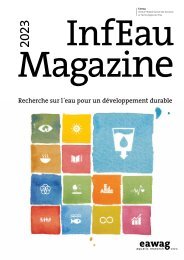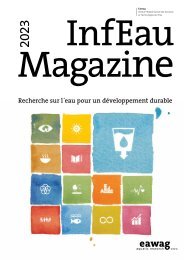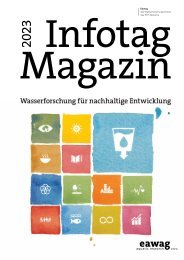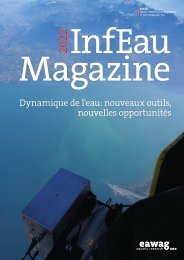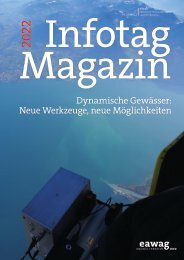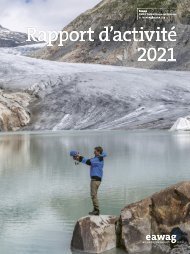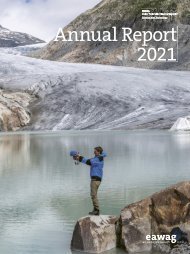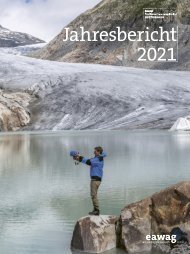Eawag Annual Report 2022
As the aquatic research institute of the ETH Domain, our research is in service of society. You can see this for yourself in our Annual Report. The annual compact review highlights the most relevant research results of the past year and shows how they were developed.
As the aquatic research institute of the ETH Domain, our research is in service of society. You can see this for yourself in our Annual Report. The annual compact review highlights the most relevant research results of the past year and shows how they were developed.
Create successful ePaper yourself
Turn your PDF publications into a flip-book with our unique Google optimized e-Paper software.
18<br />
gapmaps.org<br />
When fluoride threatens to accumulate in groundwater<br />
In the picture The map<br />
shows the probability of the<br />
fluoride concentration in<br />
groundwater being above<br />
the threshold limits set by<br />
the WHO. Virtually all of Africa<br />
and large parts of Asia have<br />
potentially hazardous fluoride<br />
exposure.<br />
Gapmaps<br />
Interactive map<br />
<strong>Eawag</strong> researchers have evaluated a huge global dataset of fluoride measurements<br />
in groundwater using an artificial intelligence-based model. They conclude:<br />
fluoride pollution endangers the health of around 180 million people, most of<br />
whom live in Africa and Asia.<br />
As an additive in toothpaste, fluoride protects our<br />
teeth from decay. But ingested in larger quantities, it<br />
can cause bones and joints to degenerate. The risk is<br />
increased especially in hot and dry regions. There, more<br />
fluoride dissolves from the rock because the rocks<br />
weather faster due to the increased temperatures. And<br />
the fluoride remains in the groundwater for a long time<br />
because due to the infrequent rainfall, the groundwater<br />
is only renewed slowly.<br />
To make matters worse, fluoride often goes undetected<br />
because it is odourless and invisible. Only water<br />
analyses provide information about excessive concentrations.<br />
But in many countries of the Global South,<br />
groundwater is hardly tested at all. “The risk areas<br />
are not known comprehensively, and there are many<br />
gaps,” says Joel Podgorski. Together with Michael<br />
Berg, Head of the Water Resources and Drinking<br />
Water Department, he developed a model that evaluated<br />
400,000 fluoride measurements in groundwater<br />
and calculated – based on topographical, geological and<br />
climatic factors – where in the world the threshold limits<br />
of 1.5 milligrams per litre will in all probability be exceeded.<br />
The work was supported by the Swiss Agency<br />
for Cooperation and Development (SDC).<br />
Fluoride concentrations are too high in southern Africa,<br />
Central Asia, China and Mongolia, for example. This is<br />
relevant to health in that many people in these regions<br />
are not connected to a network where the drinking water<br />
comes out of a tap. Those who draw their water<br />
directly from a groundwater pump are exposed to increased<br />
fluoride contamination. According to the model,<br />
around 180 million people worldwide are affected.



